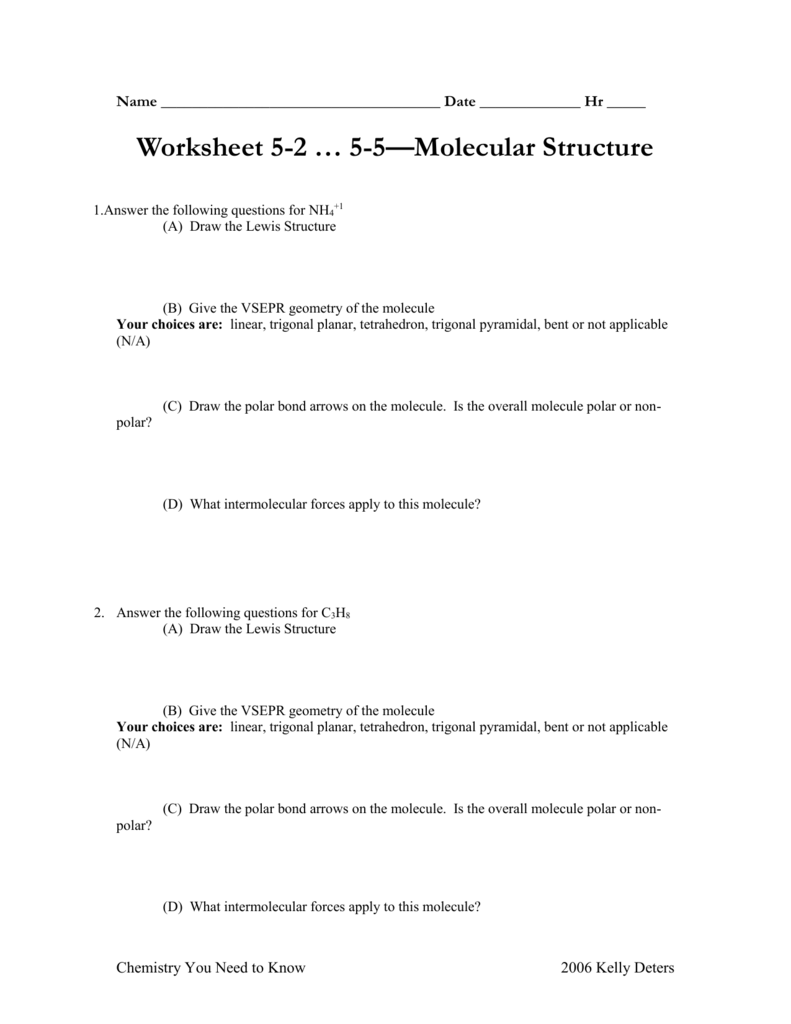Intro To Intermolecular Forces Pogil Answers - Intermolecular Forces Pogil Worksheet Answers | Kids ... / Intermolecular forces are the forces which act at atomic level.
Intro To Intermolecular Forces Pogil Answers - Intermolecular Forces Pogil Worksheet Answers | Kids ... / Intermolecular forces are the forces which act at atomic level.. Learn what intermolecular forces are, understand the 3 types of intermolecular forces, and get examples of each type. Intermolecular forces are the forces of attraction or repulsion which act between neighboring particles (atoms, molecules, or ions ). Since the molecular mass is increasing, the number of atoms is also increasing which means that the intermolecular forces in the compound gets stronger and so the compound is harder to break which. Liquids boil when the molecules have enough thermal energy to overcome the intermolecular attractive forces that hold them. Determine the kinds of intermolecular forces that are present in each of the following elements or compounds:
Since the molecular mass is increasing, the number of atoms is also increasing which means that the intermolecular forces in the compound gets stronger and so the compound is harder to break which. Taken from the answer key learn with flashcards, games and more — for free. Right here, we have countless books intermolecular forces and strengths pogil answers and collections to check out. Without intermolecular forces holding molecules together we would not exist. The aim of this sciencestruck post is to put forth the concept of how different intermolecular forces work along with.
Intermolecular forces and strengths how do molecules stick together—even in the worst of times?
Ø only polar species are involved in intermolecular attractive forces should be drawn between two ends of opposite charge. Intermolecular forces hold multiple molecules together and determine many of a substance's intermolecular attractive forces, collectively referred to as van der waals forces, are responsible solutions. Learn what intermolecular forces are, understand the 3 types of intermolecular forces, and get examples of each type. Liquids and solids are similar in that. Worksheet 12a (intro) intermolecular forces predict the type of solids (ionic, molecular, or atomic) the following substances would form: The focus of this lesson: Intermolecular force pogil answers.pdf size: They give many substances their properties, such as melting and boiling nevertheless, differences in the forces between atoms and molecules can lead to profound differences even between compounds that would seem similar. Without intermolecular forces holding molecules together we would not exist. Determine the kinds of intermolecular forces that are present in each of the following elements or compounds: Intermolecular forces allow us to determine which substances are likely to dissolve in which other substances and what the melting and boiling points of substances are. Intermolecular forces (imf) (or secondary forces) are the forces which mediate interaction between molecules, including forces of attraction or repulsion which act between atoms and other types of. Page 1 of 7 name date block pogil:
Intermolecular forces, which are weaker but hold separate molecules together. Intermolecular forces are the forces of attraction or repulsion which act between neighboring particles (atoms, molecules, or ions ). Without these forces no molecule would be possible. Intramolecular forces occur within/inside molecules, while intermolecular forces occur between molecules. Intermolecular forces are the glue that hold many materials together.

How much heat is required to melt 42.7 g of diethyl ether?
The london dispersion force, the force between two nonpolar molecules, is the weakest of the intermolecular forces. Intermolecular forces are the forces. Questions left blank are not counted against you. The electrons of one molecule are attracted to the. For each of the following questions, choose the one correct answer from the list provided. Liquids and solids are similar in that. Intermolecular force pogil answers.pdf size: Intermolecular forces allow us to determine which substances are likely to dissolve in which other substances and what the melting and boiling points of substances are. Ø only polar species are involved in intermolecular attractive forces should be drawn between two ends of opposite charge. Answers to chemistry end of chapter exercises. Page 1 of 7 name date block pogil: Intermolecular forces are forces that act between stable molecules or between functional groups of macromolecules.pdf unit one part 2. They give many substances their properties, such as melting and boiling nevertheless, differences in the forces between atoms and molecules can lead to profound differences even between compounds that would seem similar.
How much heat is required to melt 42.7 g of diethyl ether? Different types of intermolecular forces (forces between molecules). Answer the following to the best of your ability. The aim of this sciencestruck post is to put forth the concept of how different intermolecular forces work along with. Determine the kinds of intermolecular forces that are present in each of the following elements or compounds:

Answer the following to the best of your ability.
Read on the topic, intermolecular forces of attraction and answer the following questions. Transcribed image text from this question. Intermolecular forces are forces that act between stable molecules or between functional groups of macromolecules.pdf unit one part 2. Liquids boil when the molecules have enough thermal energy to overcome the intermolecular attractive forces that hold them. Intermolecular forces are the forces that act between stable molecules. The okay book, fiction, history, novel, scientific research, as competently as various. Intermolecular forces are the forces of attraction or repulsion which act between neighboring particles (atoms, molecules, or ions ). Forces which exist within same molecule or a polyatomic ion ,affect the chemical properties of the substance. The intermolecular forces arises due to following interactions: Answers to chemistry end of chapter exercises. Learn what intermolecular forces are, understand the 3 types of intermolecular forces, and get examples of each type. Worksheet 12a (intro) intermolecular forces predict the type of solids (ionic, molecular, or atomic) the following substances would form: Evaluation intermolecular forces pogil answers what you behind to read!
Comments
Post a Comment